Mysterious Magritte at MoMA
12-12-2013
Attending the Museum of Modern Art’s “Magritte: The Mystery of the Ordinary, 1926-1938,” on view through January 12, is a bit like visiting an old friend whose eccentricities are both endearing and annoying. His parlor tricks are by now so familiar that they no longer astonish, yet there was a time—the period covered by this tightly-focused exhibition—when they were novel, shocking and revelatory. The whole Surrealist enterprise blossomed and withered during those twelve years, feeding on the social, political and economic malaise of interwar Europe. Although our recent traumas pale in comparison to the aftermath of World War I, the Great Depression and the rise of Fascism, they remind us how fragile civilization’s structures are, and why visionary artists like René Magritte (1898-1967), coming of age in that uncertain era, questioned the fundamental nature of perception.
While many of the Surrealist painters and poets looked inward for inspiration, Magritte turned his gaze outward, toward the everyday world around him. But he saw it disordered and reorganized according to his own set of rules, which really amount to no rules at all. In his universe, a painting can no longer be seen as a representation or depiction of reality; it has become an idea, a concept, and a disturbing one at that. The viewer, normally as passive as Magritte’s deadpan bourgeois gentleman, is challenged to become an active navigator of this unknown territory. The old compass doesn’t work here, and the map is out of date. Throw logic out the window, and dump the window while you’re at it.

Magritte’s conflation of the mundane and the marvelous began in his native Belgium, where a reproduction of The Song of Love, a 1914 painting by Georgio de Chirico, made a profound impression and set him on the path toward his own version of metaphysical art. Magritte adapted de Chirico’s irrational juxtaposition of unrelated objects and distorted perspective in his earliest Surrealist works, a series of collages inspired by Max Ernst’s cutouts, in which two of his now-famous motifs, the bowler-hatted cipher and the baluster-like bilboquets, were introduced [left]. After the collages were exhibited in Brussels in 1927, to less than enthusiastic reviews, he moved to France and for the next few years became a key member of the Parisian Surrealist circle.
During this period, Magritte explored the interplay of words and pictures, often questioning the distinction between what we see and what we believe to be true. In The Treachery of Images, perhaps his most famous painting, a straightforward rendering of a tobacco pipe is labeled “Ceci n’est pas une pipe.” Of course a painting of a pipe isn’t actually a pipe—as Magritte pointed out, you can’t put tobacco in it—what could be more obvious? The tendency to confuse illusion with reality is epitomized in this iconic visual conundrum.
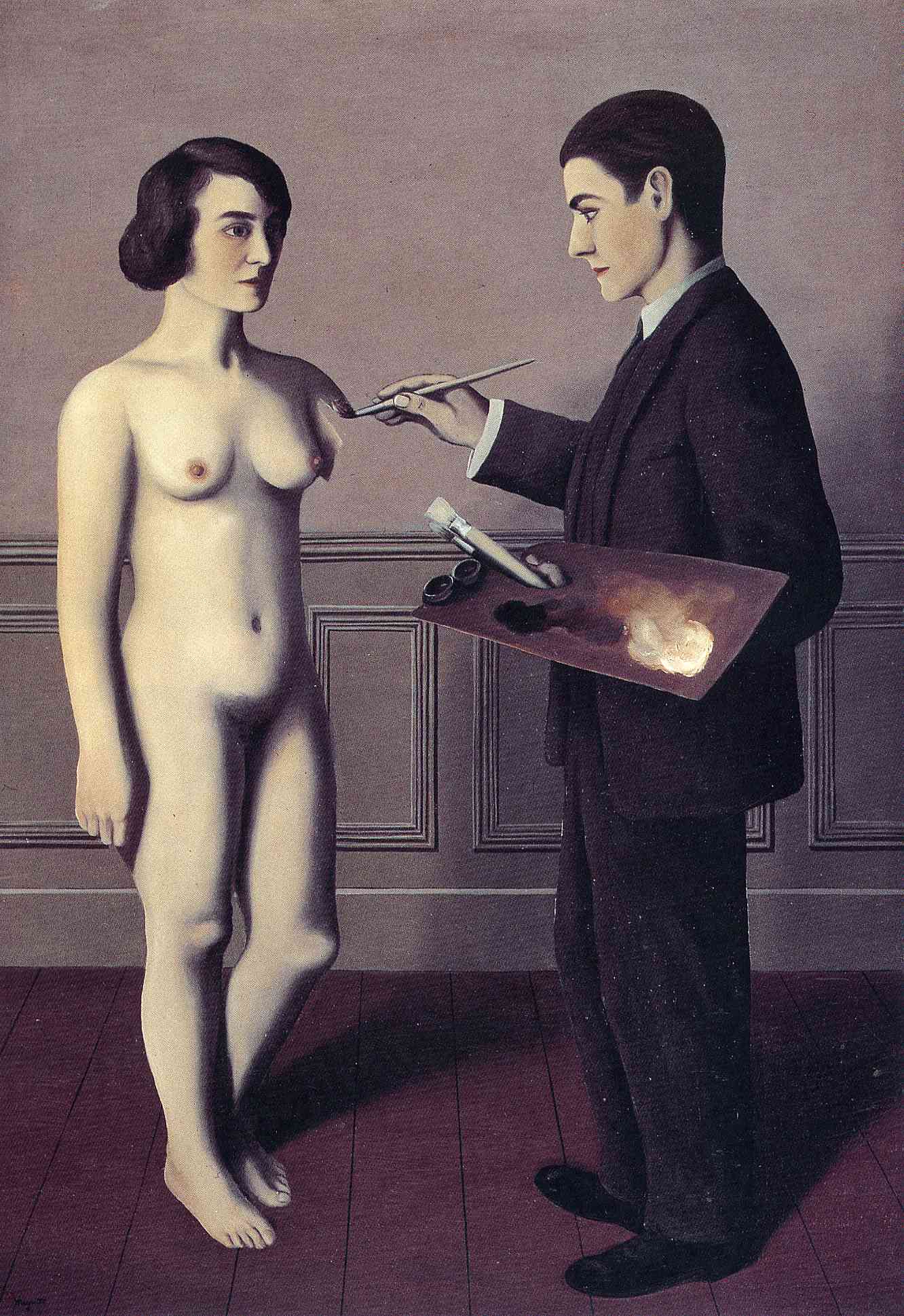
Oil on canvas, 45 11/16 x 31 7/8 inches
Lent by the Toyota Municipal Museum of Art, Japan
An even more explicit illustration, this time without a text, is Attempting the Impossible, in which the artist shows himself working on a nude portrait of his wife Georgette, only instead of painting her on canvas he appears to be making her materialize in the room. Like the pipe, her figure is ambiguous. In the real world, Georgette was always by his side, but in his art she was a figment of his quirky imagination.
In 1930 economic setbacks forced Magritte to return to Belgium, where he made ends meet as a commercial artist while continuing to develop his singularly enigmatic imagery and interacting with the local Surrealist contingent. With the exposure of his work in New York and London in the mid 1930s he began to gain wider recognition. The current show ends in 1938, after an English patron, Edward James, commissioned three large paintings that summarize Magritte’s development to date. In later years he would reprise many of those themes and motifs as demand for his signature imagery increased—another reason why, taken as a whole, his work often seems repetitious. And through countless reproductions, appropriations and parodies, Magritte has entered popular culture as the master visual punster and the avatar of cultural anomie. In these early works, however, we see him at the start of his remarkable creative journey, guided only by his desire, as he put it, “to be enriched by exciting new thoughts.”
Art Under the Microscope
11-14-2013
The aim of “Art From the Ground Up,” a symposium sponsored by the Pollock-Krasner House and Study Center at Stony Brook Manhattan last Friday, was to examine the authentication tool kit, which includes time-honored perceptive skills, diligent research, traditional forensics and the latest technology. If a work of art lacks undisputed bona fides, it has to be examined and approved by reputable authorities—connoisseurs, materials analysts and provenance investigators. To explain that process, I invited five of them to share their insights with an audience that included museum professionals, art collectors, and representatives of artists’ foundations and catalogue raisonné projects, who have a vested interest in protecting their assets from corruption.
Fakes and forgeries have been much in the news of late, most prominently in the ongoing drama of Knoedler & Company’s spectacular meltdown. (The venerable gallery, established in 1857, was forced to close when much of its inventory of modern masterpieces turned out to be counterfeits painted to order by a Chinese immigrant.) Patricia Cohen, who was awarded a 2013 Annette Giacometti Prize for her in-depth investigative reporting, covered the story in The New York Times. She gave the symposium’s closing remarks, which stressed the point that journalists, operating under various constraints, often can’t do justice to the nuances.
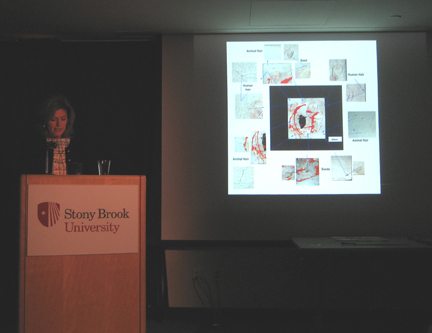
Nowhere is that more apparent than in the New York Post’s coverage of the crime-scene style examination of a painting that belonged to the late Ruth Kligman, whose five-month fling with Jackson Pollock is vividly described in her 1974 memoir, Love Affair. The presentation by Colette Loll Marvin, a researcher who is helping her estate (Kligman died in 2010) validate her claim that the painting is by Pollock, illustrated the forensic work of Nicholas Petraco, a retired New York City police detective and respected trace evidence analyst. Petraco, who teaches at John Jay College of Criminal Justice, examined foreign matter found in the painting and compared it to samples taken at and around the Pollock-Krasner House. He found enough matches—including grass seeds, sand grains, wool fibers and, of all things, a polar bear hair stuck in the paint that matches hair from a rug in the house—to conclude that the work was painted there. Unfortunately all this fascinating detective work doesn’t establish who painted it.
Authentication, as the symposium’s presenters reminded us more than once, involves connoisseurship, provenance and materials analysis, for which the standard analogy is a three-legged stool. If any leg is broken, the stool can’t stand. In the Kligman case, one leg now appears solid, while another is shaky and the third is missing. The only provenance is Kligman’s word, which is naturally suspect. What’s missing is acceptance by the connoisseurs. In the early 1990s, when Kligman submitted the painting to the Pollock-Krasner authentication board, the experts couldn’t reach a firm conclusion. They offered to include it in a supplement to the Pollock catalogue raisonné—the documentation of his known work—with the proviso that more research was needed. That left the door open to future authentication, but Kligman refused. She wanted the unequivocal approval of the board, which was disbanded when the supplement was published.
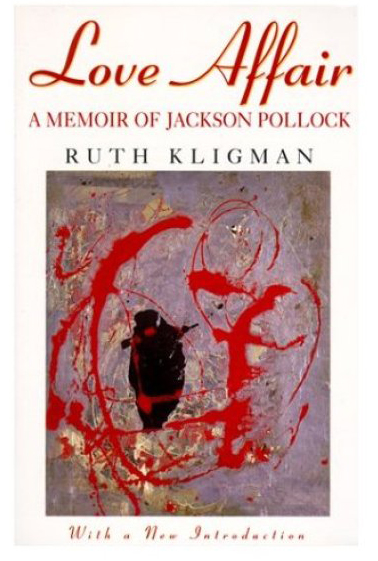 For whatever reason, the Post story and its subsequent spinoffs didn’t include this information, which Marvin discussed. Instead it was falsely reported that Pollock’s widow, Lee Krasner, personally rejected the painting out of spite, and that the board later refused to recognize it because they were “Krasner’s pals.” On the contrary, Krasner never even considered it, since it wasn’t submitted until after she died, and the board did acknowledge it, albeit with reservations. Apart from its obscure history—until 1999, when she added a new introduction to her memoir, Kligman neglected to mention it in her otherwise detailed account of virtually every moment of her liaison with Pollock—a major stumbling block is that, in the words of the eminent scholar and authentication board member Francis O’Connor, “I don’t think there’s a Pollock expert in the world who would look at that painting [illustrated on the cover of the 1999 paperback, right] and agree that it’s a Pollock.”
For whatever reason, the Post story and its subsequent spinoffs didn’t include this information, which Marvin discussed. Instead it was falsely reported that Pollock’s widow, Lee Krasner, personally rejected the painting out of spite, and that the board later refused to recognize it because they were “Krasner’s pals.” On the contrary, Krasner never even considered it, since it wasn’t submitted until after she died, and the board did acknowledge it, albeit with reservations. Apart from its obscure history—until 1999, when she added a new introduction to her memoir, Kligman neglected to mention it in her otherwise detailed account of virtually every moment of her liaison with Pollock—a major stumbling block is that, in the words of the eminent scholar and authentication board member Francis O’Connor, “I don’t think there’s a Pollock expert in the world who would look at that painting [illustrated on the cover of the 1999 paperback, right] and agree that it’s a Pollock.”
So although the painting has failed the three-legged-stool exam, the headlines blare, “CSI tests authenticate Pollock’s final work,” and “Mistress Proved Right.” As with many such disputes, time, and the art market, will decide the merits of that claim.
Forever Young in the Hamptons
10-17-2013
Twenty years ago this month, in the October 1993 issue of ARTnews magazine, I reviewed an exhibition at Glenn Horowitz Booksellers in East Hampton. The show was titled “Young in the Hamptons,” and it comprised photographs from the 1950s and ‘60s by John Jonas Gruen. The column prompted a gracious note from John, whom I had met once or twice socially, thanking me for the writeup and mentioning, much to my surprise, that it was his first solo show and the first time his photographs had been reviewed. Since then that body of work has been collected in a book, The Sixties: Young in the Hamptons, published in 2006, and sampled for several exhibitions, including a selection of artist portraits at the Whitney Museum in 2010. Its latest incarnation is now on view, through the end of the month, at Susan Eley Fine Art in Manhattan.
Best known as an art and music critic, composer, biographer and memoirist (author of The Party’s Over Now and Callas Kissed Me… Lenny Too!), John and his wife, the painter Jane Wilson, bought their Water Mill carriage house in 1960. The picturesque property, south of the highway, with its spacious hayloft studio overlooking potato fields, was purchased with the proceeds from the sale of one of Jane’s paintings. Yes, I said one painting. If that makes you sigh and murmur, “those were the days,” wait until you see the pictures of them and their friends sipping cocktails on the patio and frolicking on nearby Flying Point Beach. They’ll make you nostalgic for the days when everyone smoked.
 Like any good host and hostess, John and Jane made their guests feel welcome and comfortable, an attitude that’s reflected in the photographs. These are not candid, fly-on-the-wall images in which people are caught off guard. With an eye sharpened during a stint as a photo agent dealing with the work of such notables as Man Ray, Bill Brandt and Brassaï, John achieved an admirable blend of sympathetic observation and character study, revealed more by body language than by facial expression. Whether individual portraits or groupings, most are posed, and even in the casual moments there’s an evident rapport between the photographer and his subjects. Apparently mugging and clowning for the camera was part of the fun of these social occasions. What elevates them above the level of generic party snapshots is John’s flair for just the right combination of people and settings, plus the fact that these are no ordinary people. In one famous beach gathering [above], for example, you have Robert Rauschenberg, Jasper Johns, Grace Hartigan, Larry Rivers, Jane Freilicher and John Bernard Myers, among others.
Like any good host and hostess, John and Jane made their guests feel welcome and comfortable, an attitude that’s reflected in the photographs. These are not candid, fly-on-the-wall images in which people are caught off guard. With an eye sharpened during a stint as a photo agent dealing with the work of such notables as Man Ray, Bill Brandt and Brassaï, John achieved an admirable blend of sympathetic observation and character study, revealed more by body language than by facial expression. Whether individual portraits or groupings, most are posed, and even in the casual moments there’s an evident rapport between the photographer and his subjects. Apparently mugging and clowning for the camera was part of the fun of these social occasions. What elevates them above the level of generic party snapshots is John’s flair for just the right combination of people and settings, plus the fact that these are no ordinary people. In one famous beach gathering [above], for example, you have Robert Rauschenberg, Jasper Johns, Grace Hartigan, Larry Rivers, Jane Freilicher and John Bernard Myers, among others.
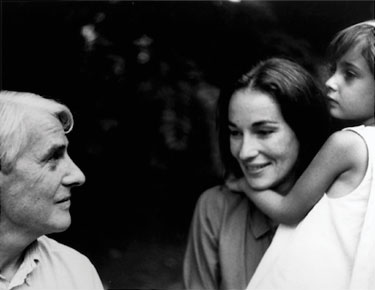
Jane Wilson, whose day job as a fashion model paralleled her painting career, is the recurring presence that anchors these fleeting occasions. She and the camera clearly have a thing going. From her first appearance, caught in a pensive moment during a 1957 visit to friends in the area, through the round of cocktail parties and beach outings that punctuated the 1960s chez Gruen, she stands out among the host of luminaries. The picture of her holding their daughter Julia, age 4, while Willem de Kooning flirts with them both, documents her outer and inner beauty, as well as de Kooning’s good taste in women. This could have been cloyingly sentimental, but instead it has a frisson generated by Julia’s slightly apprehensive expression, while Jane smiles warmly but knowingly.
Speaking of de Kooning, who was closing in on 60 when this picture was taken, it must be said that not everyone in Young in the Hamptons can honestly be called young. Of course Julia qualifies, as do Lisa de Kooning and the other children in attendance. But most of the adults were born in the 1920s, and a few, like de Kooning, Fairfield Porter and Stella Adler, are of pre-war vintage—World War I, that is. On the other hand, if it’s true that you’re as young as you feel, then the joie de vivre that radiates from John’s photographs entitles everyone he pictured to honorary membership in the Hamptons Youth Club.
Eye On Main Street Art
9-19-2013
A walk down Riverhead’s Main Street is a journey along small town arteries everywhere: an eclectic mix of architectural periods and styles, and a lot of empty storefronts. Remember Woolworth’s? Gone. McCabe’s? Closed. Swezey’s? Vacant—well, not quite. For the past few months, the former Swezey’s display windows have been occupied by an installation by Andrea Cote, a multimedia artist who lives in nearby Flanders. Her ambitious project, “Eyes On Main Street,” aims, in her words, “to promote an awareness of the rich and varied spaces and stories of Riverhead’s citizens.” This appealed to me not only because my column is called “Eye On Art,” but also because I have a longstanding interest in public art and how it addresses and responds to its audience. In Andrea’s project, there is no separation between them, since the audience is the art.
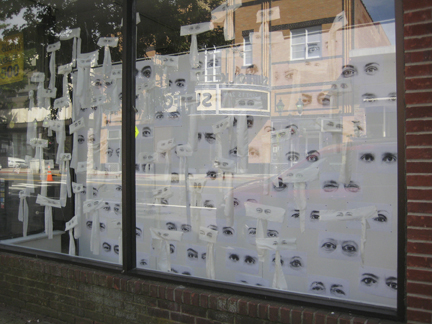 The eyes in question are those of some 100 local residents, natives and newcomers alike, whom Andrea photographed during the spring and summer, beginning in May at the annual Community Mosaic Street Painting Festival, an outdoor participatory art event that’s also a huge block party. It’s all part of the downtown revitalization effort, which is using educational and cultural attractions like the East End Arts Council, Atlantis Marine World, the Long Island Exhibition Center and the Peconic River Walk, as well as the gorgeously renovated Suffolk Theater, vintage 1933, to bring people back to Main Street for reasons other than retail. As they stroll past what was Swezey’s department store, they encounter an array of translucent gauze masks on which photographs of eyes have been printed. Another window features photographs of people wearing the masks, covering their own eyes with someone else’s. The artist herself sports several of them in deadpan self-portraits, posed in front of the locale associated with each subject. In this way, she and the others who wear the masks metaphorically view Riverhead through the eyes of people who are intimately connected to the town, from recent arrivals like Glynis Berry, who opened the art sites gallery on West Main Street in 2007, to Anthony Meras, the third-generation proprietor of Star Confectionery, in business at 4 East Main Street since 1911.
The eyes in question are those of some 100 local residents, natives and newcomers alike, whom Andrea photographed during the spring and summer, beginning in May at the annual Community Mosaic Street Painting Festival, an outdoor participatory art event that’s also a huge block party. It’s all part of the downtown revitalization effort, which is using educational and cultural attractions like the East End Arts Council, Atlantis Marine World, the Long Island Exhibition Center and the Peconic River Walk, as well as the gorgeously renovated Suffolk Theater, vintage 1933, to bring people back to Main Street for reasons other than retail. As they stroll past what was Swezey’s department store, they encounter an array of translucent gauze masks on which photographs of eyes have been printed. Another window features photographs of people wearing the masks, covering their own eyes with someone else’s. The artist herself sports several of them in deadpan self-portraits, posed in front of the locale associated with each subject. In this way, she and the others who wear the masks metaphorically view Riverhead through the eyes of people who are intimately connected to the town, from recent arrivals like Glynis Berry, who opened the art sites gallery on West Main Street in 2007, to Anthony Meras, the third-generation proprietor of Star Confectionery, in business at 4 East Main Street since 1911.
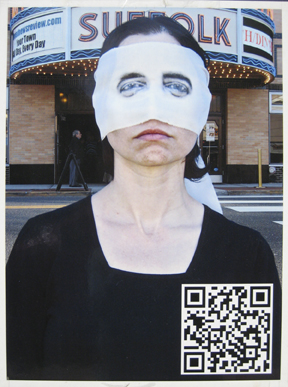
But this is not simply a static installation documenting a series of photo shoots. Andrea’s self-portraits also include QR codes that allow viewers with scanners on their smart phones or tablets to access video interviews with the eyes’ owners. You can watch, among others, EEAC director Pat Snyder talking about her organization’s wide range of arts programming; Bob Spiotto, former Suffolk Theater executive director, doing a star turn on stage; performance artist Judy Sky, whose grandfather owned the Vail-Levitt Music Hall, channeling Judy Garland and recalling the history of the venue, which opened in 1881 on Peconic Avenue, just off Main Street; and Rob DiGiovanni, director of the Riverhead Foundation for Marine Rescue and Preservation, showing how to give a medical exam to a reluctant seal. And if you’d prefer not to spend time looking at videos when you could be enjoying all the cool attractions that Main Street has to offer, you can watch at home by visiting eyesonmainstreetriverhead.com.
There’s a bittersweet undertone to “Eyes On Main Street.” While many of the interviewees are upbeat and optimistic about the town’s future, there’s no rah-rah Chamber of Commerce boosterism. Naturally you expect nostalgia from those who remember the town’s heyday, when the whole high school football team piled into the luncheonette after a game, and you could get a strip of photos for a quarter in the booth at the back of Woolworth’s. But in spite of its emotional nuances and engaging personalities, the picture feels incomplete. Where are the lawyers and judges and court personnel who dominate the Suffolk County seat’s professional class and work only a few steps from Main Street? Where are the people of color? The Riverhead of this project is less a mosaic than a jigsaw puzzle with some crucial pieces missing.
Corbu’s Conundrums
8-22-2013
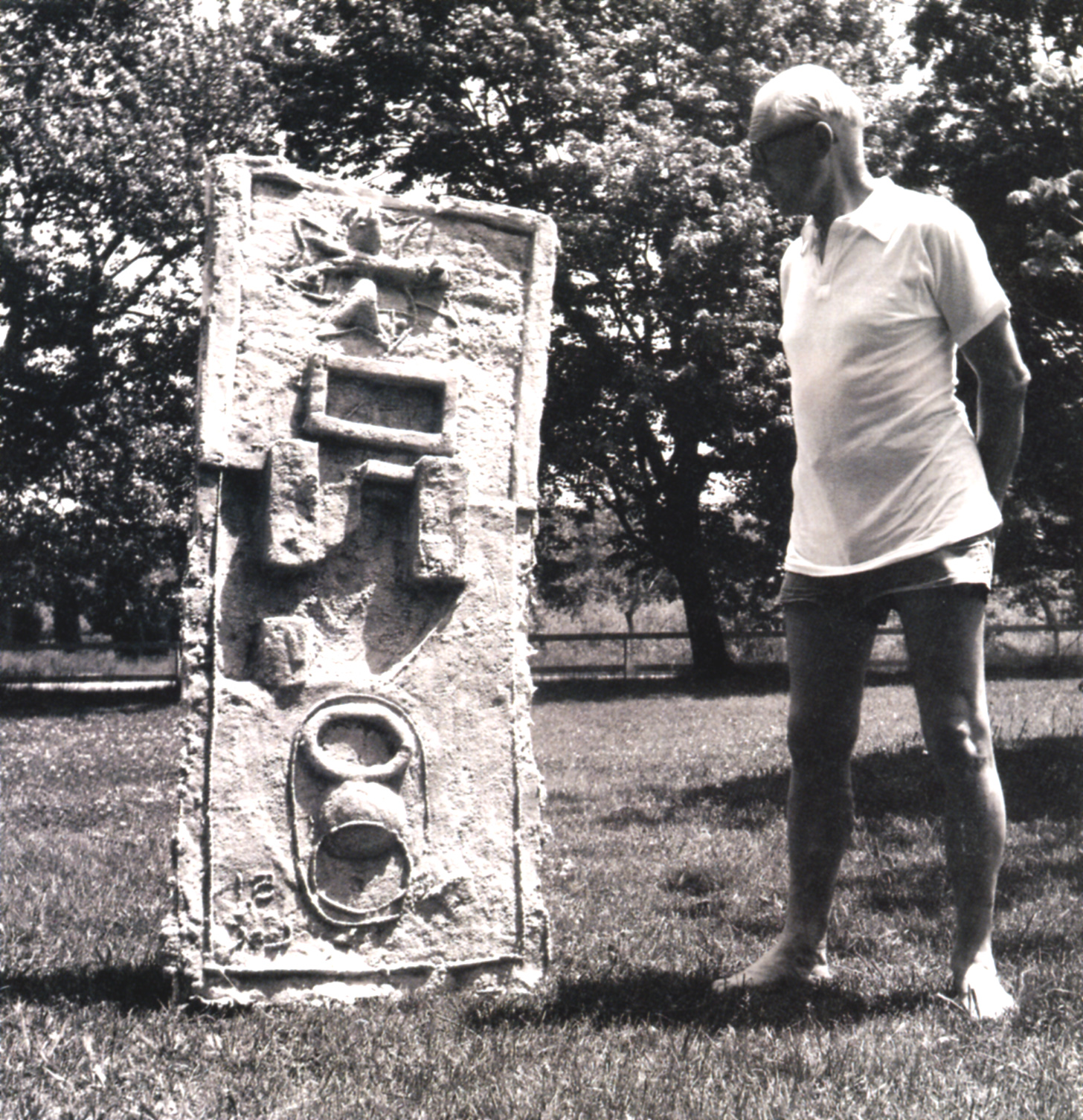
On a summer afternoon in 1951, the Swiss architect, artist and theorist Charles-Édouard Jeanneret-Gris—known professionally as Le Corbusier—found himself on an East Hampton beach in the company of the Nivola family. In New York to work on an ill-fated commission for the United Nations headquarters, he had first visited the Nivolas the previous year, when he painted two murals in their house on Old Stone Highway. Evidently he was intrigued by the sand-casting technique that his host, the sculptor Costantino Nivola, had developed while playing on the shore with his kids. By hollowing out shapes in the wet sand and filling them with plaster, Nivola created reliefs that, with Corbu’s encouragement, evolved into large architectural installations. Corbu himself experimented with the process, creating a cast-plaster panel that is now on display in “Le Corbusier: An Atlas of Modern Landscapes,” at the Museum on Modern Art.
I am far from alone in pointing out that the exhibition’s problems begin with its title. In Archinect, Ross Wolfe describes the theme as “superfluous and tacked on,” while Martin Filler, in the New York Review of Books, notes that no amount of curatorial emphasis on how Corbu framed the landscape in views from ribbon windows can counter “his reputation as a megalomaniacal city planner” whose enormous apartment blocks epitomize all that went wrong with 20th century urbanism. Writing in The New York Times, Michael Kimmelman called the show’s premise “tendentious,” since Corbu’s early landscape paintings and the few natural objects he collected, which apparently inspired some of his structural forms, do little if anything to revise his image as a doctrinaire formalist whose buildings often stick out from their surroundings like geometric sore thumbs. Nature was far too chaotic for his taste. Indeed, as envisioned by Corbu, the modern landscape was a product of human intervention, shaped in the service of the built environment.
Why not just forget the title and take in the vast scope of Corbu’s accomplishments, presented here in MoMA’s first-ever comprehensive survey? I think that makes sense, although there are still other weaknesses in this panoramic overview of the master’s career. One is the contradictory character of his apparent aims. Adopting a pseudonym derived from a family surname, as Le Corbusier he co-founded an art movement known as Purism, which advocated clarity and rationality. But the paintings on view are hardly distinguishable from the Cubism he denounced as decorative. This reductive impulse translated more effectively into his architectural designs. Although he maintained that the architect creates “in observance of the laws of nature,” he was talking about gravity, tension, weight, and other such physical laws. Nature was a force to be reckoned with, but more as an adversary than an ally.
Corbu’s famous concept of a building as a “machine for living in” had worldwide impact, not only on his own commissions—from single family homes like the Villa Savoye to an entire planned city in the Punjab—but on modernist architects’ fundamental approach to design problems. He is often blamed for the destruction of rundown but vibrant urban neighborhoods in favor of sterile towers, although his own plans for such monoliths remained on the drawing board. Those plans are in the show, together with many fascinating original scale models, concept sketches and other documentation, period films of Corbu explaining himself, and beautiful contemporary photographs (mounted way too high) of several notable buildings. It’s hard to get a sense of scale and proportion without actually visiting the buildings themselves, and a few reconstructed rooms do little to conjure the experience of place, but the insights into Corbu’s thought process more than compensate. This is, after all, an exhibition, not a house tour.
Given his penchant for unadorned structures, amply illustrated at MoMA, it’s hard to understand Corbu’s interest in Nivola’s sand-casting technique. After the solitary experiment in 1951, which he left at the Nivola house, it seems he never tried it again or chose to use anything like it to embellish his buildings. But even as an anomaly the plaque is interesting, although why the curators chose to display it flat is anyone’s guess. It was intended to be a wall piece, but at MoMA it’s lying on a raised base, looking more like a lumpy coffee table than a bas relief. As I was pondering this decision, without any prompting from me a nearby group was debating the same question. Nevertheless, it was created horizontally, exploiting the inherent qualities of wet beach sand, and in its modest way it represents the closest Corbu ever got to conforming to nature’s dictates.
Three in One at the Parrish
7-25-2013
If we needed a reminder that art is a reflection of the personalities and experiences of those who create it, the current exhibition at the Parrish Art Museum offers ample evidence. “Angels, Demons, and Savages,” on view through October 27, was organized by Klaus Ottman and Dorothy Kosinski for the Parrish and the Phillips Collection in Washington, DC, where it premiered in the spring. The show focuses on a critical moment of interaction among three artists who were paying close attention to one another’s work at a time when modern art was being redefined in the aftermath of World War II. Like the balance of political and economic power, cultural momentum had shifted westward, but certain members of the French avant-garde had fervent admirers in America. One of the most highly regarded was Jean Dubuffet (connoisseur of “savage” art brut), whose interaction in the early 1950s with the American Jackson Pollock (he of the demons) and the Filipino-American Alfonso Ossorio (middle name Angel) is the exhibition’s raison d’être.

It was Ossorio who recognized and nurtured the artistic kinship and became a close friend of Dubuffet, although he failed to forge a personal bond between Dubuffet and Pollock. The two may have met briefly at Ossorio’s MacDougal Alley studio, but it never went further. More important, however, was Pollock’s admiration for Dubuffet’s work, which he saw at New York galleries and later at Ossorio’s East Hampton estate, The Creeks. The calculated rawness of Dubuffet’s approach to both subject matter and technique clearly struck a sympathetic chord. For his part, Dubuffet was sufficiently impressed by Ossorio’s opulent, multi-layered paintings and works on paper to write a monograph about them, in which many of his own attitudes are echoed. For Pollock’s 1951 show at the Betty Parsons Gallery, Ossorio wrote an eloquent catalogue essay, using descriptions that could be applied just as well to Dubuffet’s work or his own.
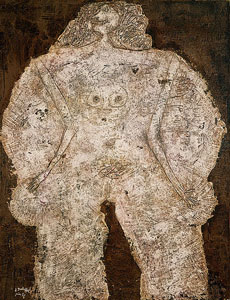
They formed a kind of aesthetic triangle—or, from Ossorio’s perspective, a trinity. The Roman Catholic symbolism that pervades his imagery is absent from Pollock’s and Dubuffet’s, but the relationship between the earthly and spiritual realms plays out in all three artists’ work. If there’s one element that unites them, it’s the striving for some truth beyond superficial appearance, an essence that is the goal of abstraction. They also shared a concern with the materiality of their paintings—the sense that they’re made of a substance that has its own distinctive character, whether it’s Pollock’s enamel paint or Ossorio’s wax resist or something resembling earth concocted by Dubuffet. A fascinating section in the catalogue discusses their innovative materials and techniques.
Praise for fellow artists’ work is one thing, but Ossorio put his money where his mouth was. As a man of means (scion of a Philippine sugar magnate), he collected their art, gave them studio space on the grounds of his estate, and housed Dubuffet’s collection of l’art brut for some ten years. Interior photographs of The Creeks in the 1950s show works by Dubuffet, Pollock, Clyfford Still, Lee Krasner, and Ossorio himself. His patronage, as well as his moral support, was crucial to Pollock, especially after he returned to using figurative imagery. In addition to five classic poured paintings, including the 1950 masterpiece, Lavender Mist (now in the National Gallery), Ossorio owned two of the black enamel paintings from 1951-52 in which abstracted human and animal forms are evident.
Unfortunately Lavender Mist, the highlight of the Phillips installation, could not travel to the Parrish, and several other pieces were excluded owing to lack of space. It’s ironic that the big new building doesn’t have enough room for a show of just over 50 works, some of them quite small. Nevertheless, the claim that these three artists influenced one another in significant ways that have not been fully appreciated is borne out by the examples on view. The big disappointment is how they look in the galleries. The lighting is so uniform and subdued that textural subtleties and chromatic nuances are lost. More graphic and monochromatic, the Pollocks pretty much hold their own, but the Dubuffets and all but the most high-key Ossorios look dingy. Vis-à-vis the Phillips, the comparison is dusk to daylight. A show as illuminating as this one deserves better illumination.
Artists & Writers: How Old?
6-27-2013
In a switch on the common habit of shaving off a few years, the annual Artists & Writers Softball Game has added a few. The claim that the first pitch was hurled back in 1948 has been around since at least 1998, which was billed as the 50th anniversary. But was it really? As the venerable contest marks yet another milestone, I was hoping that the research behind Guild Hall Museum’s current exhibition, “Artists & Writers: They Played in the Game,” on view through July 28, would answer that question. No such luck.
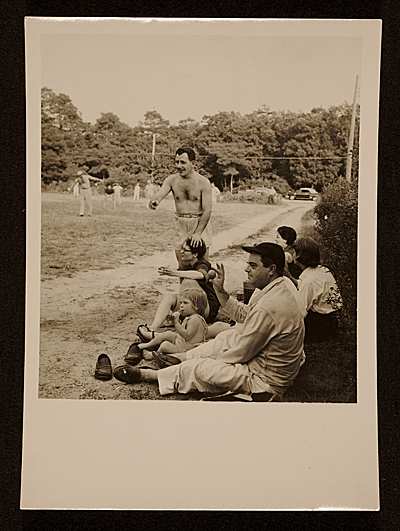
The show is a joyful romp around the bases, from the first documented casual outing in 1954—captured in two photographs and described by Harold Rosenberg, the art critic and only participating writer, as not so much an athletic event as a “preliminary to cocktails”—to last year’s 10-inning celebrity slugfest for charity. Hard evidence is very thin prior to the first fundraiser in 1968, recapped in the East Hampton Star as the 4th annual, moving it at least ten years forward from its recorded origin and further confusing an already obscure history. Let’s face it, if it did begin, as legend has it, in sculptor Wilfrid Zogbaum’s yard, it wasn’t in 1948. He didn’t move to Springs until the early 1950s.
So where does that date come from? Even veteran sportswriter Jack Graves, who has compiled a chronology based on Star reporting over the decades, has fallen back on speculation. His investigative journalism reveals that the purported 1948 game was “played somewhere,” and is “recorded only in memories.” Will it take a subpoena to get Jack to reveal his sources? Inquiring minds would also like to know who placed Jackson Pollock in the lineup. He was the quintessential anti-athlete, the guy who was expelled from high school for complaining about too much emphasis on sports, and whose only known exercise was lifting a beer bottle to his lips.
That said, it’s always a treat to see Guild Hall’s magnificent 1951 Pollock drawing, although a disclaimer on the label would have been nice. (Let’s call him the first honorary ringer.) There are excellent examples by some genuine early participants, including Franz Kline, Ludwig Sander, Philip Pavia, David Slivka, Howard Kanovitz, Herman Cherry and Willem de Kooning (dismissed by Pavia as a “lousy player”), as well as stalwarts of the 1960s like Ray Parker, Warren Brandt, Bill King, Esteban Vicente, Kyle Morris and Syd Solomon, whose yard became the venue. Apart from Elaine de Kooning and Joan Mitchell, female artists and writers didn’t enter the fray in numbers until the 1970s.
The fact that many of the works in the show are from the museum’s collection is a testament to the wisdom of focusing on representing artists of the region, many of whom have humiliated themselves repeatedly on the field of broken dreams. Few if any have a longer tenure among the perpetually pathetic Paletteers than Leif Hope, impresario of the charity game, which was inaugurated as a fundraiser for Eugene McCarthy’s 1968 presidential campaign. Eric Ernst, a real glutton for punishment, first faced the mound at the tender age of 12, or was it 13? (Another fuzzy statistic, but hey, this is a competition where even the final score is often in dispute.)
In 1970, the matchup raised $500 for the legal defense fund of artist Robert Gwathmey, who had been cited for defacing the American flag with a peace symbol. As usual, the artists went down to defeat, but by only one run instead of the typical shellacking. A rare poster for that event is among those in the memorabilia gallery, replete with T-shirts, caps, and videos of play and sideline interviews. Here too is the Scriveners’ deep bench of publications—but incredibly, none of Harold Rosenberg’s books. Also missing, although billed in the gallery handout, is a Gwathmey painting from the Guild Hall collection. Considering his fundraiser’s iconic status in the annals, it’s an odd omission.
What once was amateur recreation notable for its ineptitude has evolved into a star-studded spectacle that Graves laments has been “discomfortingly well-played in recent years.” The roster now boasts movie stars and supermodels moonlighting as artists, and a scribes’ squad that runs the gamut from Pulitzer Prize-winners to those whose literary talent is confined to check-writing. But be the players bona fide or bogus, the aim is to support local non-profits. And by that measure, whether the game is really 65 years old or only 59, it just gets better with age.
Expressionism Today
5-30-2013
A group of local artists, joined by a guest from California, convened at the Pollock-Krasner House on May 19 to discuss the contemporary relevance of expressionism, whether abstract or figurative, and how it relates to their own work. The event, sponsored by Drs. Marika and Thomas Herskovic, harked back to the early days of the New York School, when artists hotly debated such issues at The Club. It attracted a large audience, whose comments sparked some lively responses. As moderator, my job was to make sure everyone got his or her say.
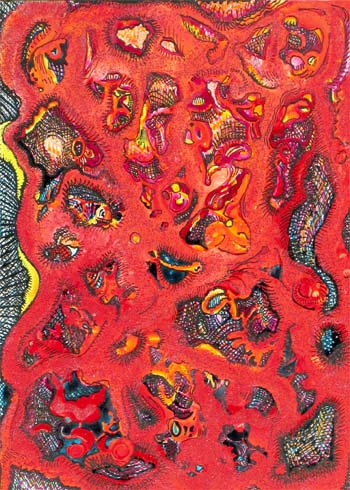
For expressionists, they proved to be a remarkably well-behaved bunch, reserving any emotional outbursts for their interactions with the canvas. Actually not all of them are purely painters. Ruby Jackson also makes sculpture, and both Colin Goldberg and Carol Hunt use digital technology as well as brushwork, and are inspired by Asian calligraphy. The artists’ approaches were as varied as their media, so there was a general reluctance to embrace a unifying label. Haim Mizrahi set the tone when he quoted Willem de Kooning’s famous warning, “It is disastrous to name ourselves.” That said, there was consensus on the fundamental need for spontaneity, whether it’s an expression of internal impulses or a reaction to outside stimuli. The underwater world, with its marvelous creatures and intriguing shapes, is the key that unlocks Ruby’s imagination. In Carol’s case, what began as a fascination with fabric patterns has evolved into a complex vocabulary of abstract forms.
The term “abstract” has long been a bugbear, implying a lack of recognizable subject matter, but as Haim pointed out, “just because it isn’t evident doesn’t mean it doesn’t exist.” Connie Fox was glad that the abstract qualifier has become divorced from expressionism, freeing the artist from prohibitions against figurative imagery. For her, as for others on the panel, the real task is to engage with the work as it evolves, to follow where it leads and dispense with preconceptions. Colin maintained that, far from constraining him, the computer encourages that kind of improvisation; he thinks of digital technology as “a tool to tap into the unconscious.” A question from the audience provoked several musings about the psychological aspects of creativity, and how the artist gains access to that Jungian reservoir. Our West Coast panelist, Linda Hatofsky, spoke on behalf of her late husband Julius, a longtime teacher at the San Francisco Art Institute, who told his students to “take your mind out of the work and let your hand guide you.” There were nods of concurrence around the table.
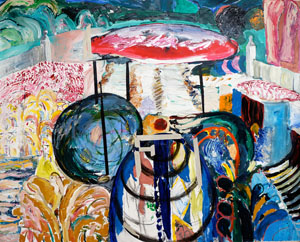
Art as a process of self-discovery—perhaps expressionism’s key defining quality—was a recurring theme. Linda described how her husband’s traumatic experiences in World War II, including the liberation of a concentration camp, were eventually manifested in his paintings decades later. For Haim, art is “a constant investigation of who we are,” while for Ruby it’s a vehicle that lets you “go someplace you have never been.” Connie mentioned how the act of looking inward helps focus attention where it needs to be. Sally Egbert eloquently evoked the artist’s “rare space,” a private realm shut off from daily life. Yet far from being lonely, or out of touch with reality, that space is filled with the residue of experiences that are carried into the studio and translated into meaningful imagery. Expressionism isn’t only about self-expression, she insisted. To her, “communication is key.” An audience member elaborated on the distinction between “painting your feelings,” which might be considered mere navel-gazing, and “painting with feeling,” implying a broader empathy with the zeitgeist, to which Sally replied that “really great art should be of its time, but timeless.” That’s something we can all agree on.
A Fine Show at Spanierman Modern
05-02-2013
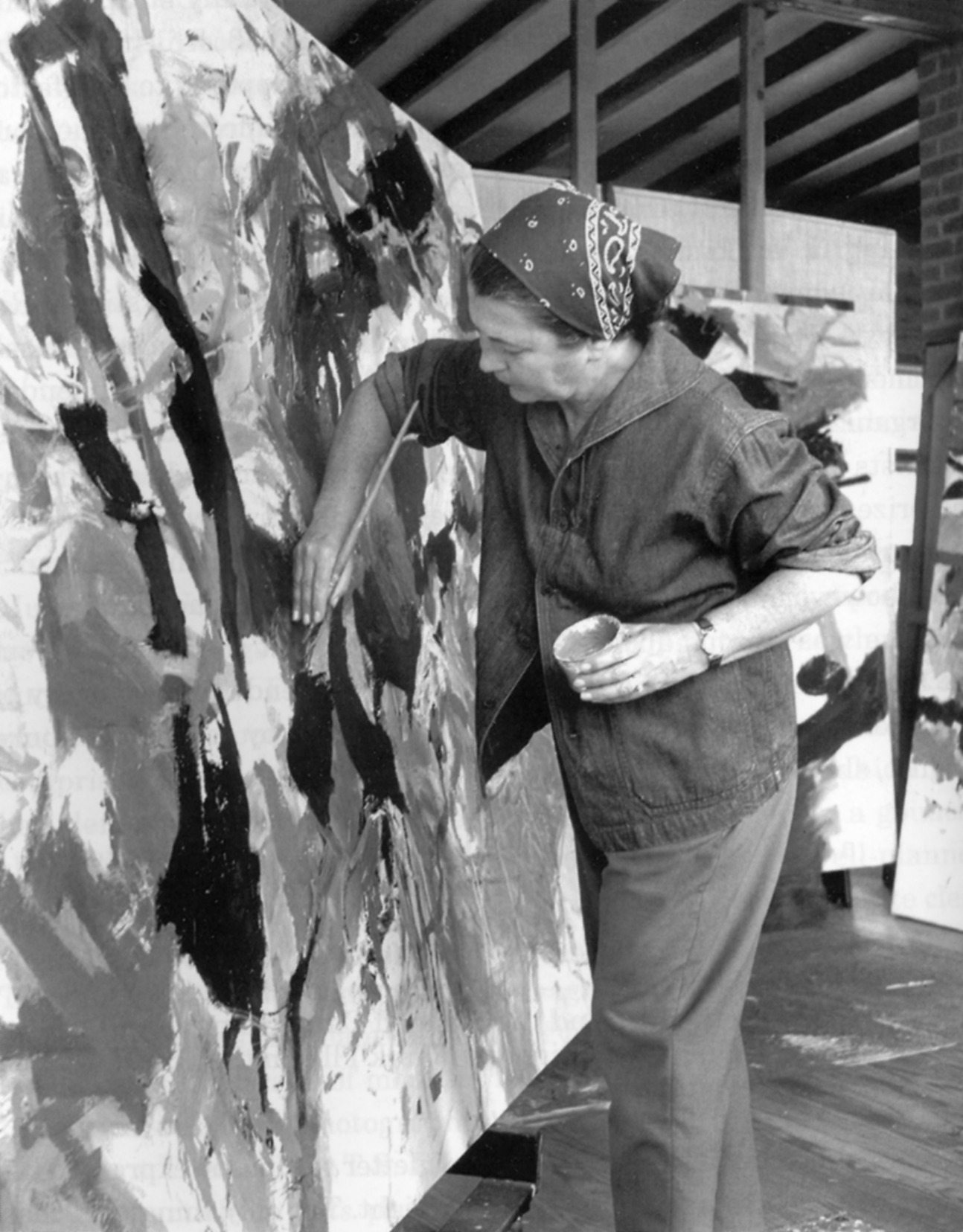
When Willem de Kooning visited Perle Fine’s Springs studio in the late 1950s, he remarked that her abstract imagery “is what you see out here, isn’t it? You know, through a big studio window.” Not wanting to hurt her old friend’s feelings, Fine replied “well yes, I guess so, if you say so,” while silently contradicting him. As she later told an interviewer, “of course it wasn’t.” Yet she also admitted that living in the country—literally off the beaten path on Red Dirt Road, which wasn’t even cut through until 1954, when she and her husband Maurice Berezov bought land there and had the town bulldoze a right-of-way to it—did have a subtle, even subliminal, effect on her work. As she saw it, her city paintings tended to be more “cerebral,” while the country paintings seemed “more open and more relaxed.” You can judge the merits of this observation at Spanierman Modern in Manhattan, where “Perle Fine: 30 Years of Painting,” is on view through May 24.
The exhibition’s earliest pieces date from the 1940s, when Fine was transitioning from a geometric style to a more organic approach to abstraction. Her previous works were heavily indebted to the Cubist principles of her teacher, Hans Hofmann, and the strict Neo-plasticism of Piet Mondrian, whom she befriended in New York and considered the most important influence on her art. Her admiration for him was so deep and well known that in 1947 she was commissioned to make an exact copy of his final masterpiece, “Broadway Boogie-Woogie.” She once said of his philosophy, “in everything I’ve ever done you see a trace of that, in some more strongly than others.”
Again the show allows you to decide whether or not that’s true, as it runs the gamut from “End of Day,” a pictographic composition from 1945, to “Sunscape,” a minimalist 1975 canvas. It also includes a couple of the works made soon after her move to Springs, notably the major 1959 diptych, “Tournament,” and several paintings from her Cool series of the 1960s. I think Fine was right to insist that Mondrian’s grid underpins even her most exuberant abstractions, and it evidently informs the rectangular structure of the Cool canvases, which are far from chilly or detached in mood. Their vibrant color and sensuous finish argue against any such reading. Cool can have so many meanings, and in this case I see it as denoting the transcendent restraint, filtered through Mondrian, Albers and Rothko, that characterizes these canvases.
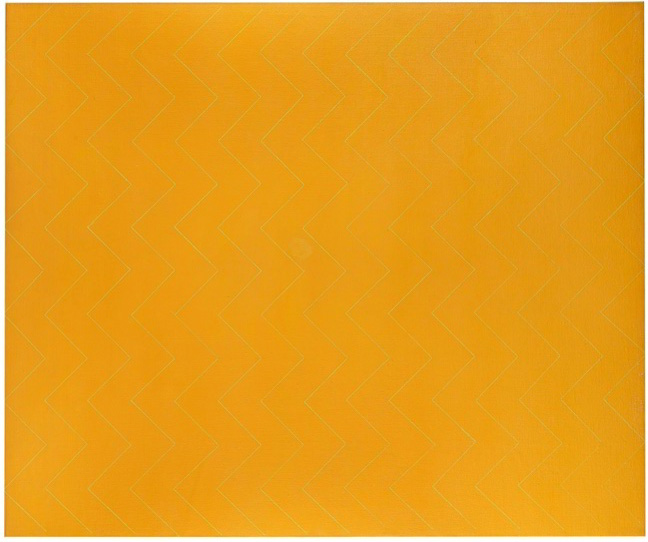
After many years of summering in Provincetown, where she painted in the Days Lumber Yard studios cheek by jowl with her fellow artists, Fine chose Springs as a permanent home at the urging of Lee Krasner, a close friend from their Hofmann School years. Like Krasner, Pollock and the other artists flocking to the East End after World War II, Fine enjoyed the benefits of country living with easy access to the New York art scene. Her relative isolation apparently freed her from the constraints she felt in the city and allowed her to respond indirectly to her surroundings. As she later acknowledged, the rural environment contributed in some measure to her imagery. Some of her paintings allude indirectly to natural forms, like the dark forms of trees in a snowy landscape, water rippling in a shallow pool, or a summer afternoon’s radiant atmosphere—which may be why she titled a 1960 painting “Winter,” a 1974 composition “A Criss-Cross of Currents,” and her golden 1975 canvas “Sunscape.”

While continuing to exhibit regularly in Manhattan, Fine operated outside the art-world mainstream, yet her work reflects some of the major trends of the era. Her collage paintings of the 1950s, including “Tournament” and “Billet Doux,” are Abstract Expressionist classics, and her Cool series, begun in 1961, looks like textbook Color Field painting, but you won’t find her mentioned in the standard histories of either movement. This may be due in part to her reticence; her colleague Robert Richenburg described her as “quiet and remote, off in her own cloud.” She hated the rough and tumble of self-promotion. And let’s face it, female artists of her generation—she lived from 1905 to 1988—were long neglected by both the chroniclers and the marketplace. I trust we’re now enlightened enough to judge Fine’s work on its merits, not by the artist’s sex.
Gutai at the Guggenheim
4-4-2013
Geographically, Ashiya, Japan is a long way from East Hampton, New York—roughly 10,000 miles—but artistically those two towns are closer than you might imagine. The connection is the feeling of kinship with Jackson Pollock that was felt by members of the Gutai Art Association, established in Ashiya in 1954. In the words of its founder, Jiro Yoshihara, Gutai’s aim was to “pursue enthusiastically the possibilities of pure creativity.” The group’s name means “concreteness,” and its manifesto scorned traditional illusionistic art as fraudulent because the material it’s made of—paint, cloth, metal, stone—represents something other than itself. “Gutai Art does not alter matter,” Yoshihara declared, “Gutai Art imparts life to matter.” It’s easy to see why the group related to Pollock.
The fruits of this iconoclastic attitude are on full dress parade in Gutai: Splendid Playground, a truly marvelous exhibition on view through May 8 at the Guggenheim Museum. It’s billed as the first North American museum show devoted to Gutai, but strictly speaking that’s not true. It was actually inspired by a 2009 exhibition, Under Each Other’s Spell: Gutai and New York, at the Pollock-Krasner House. Organized by Ming Tiampo, co-curator of the Guggenheim show, Under Each Other’s Spell explored the direct connections between the Japanese and New York avant-gardes, especially the Gutai-Pollock link. It was narrowly focused and of course far smaller than the extravaganza that now occupies Frank Lloyd Wright’s Fifth Avenue landmark, but it set the stage, so to speak.
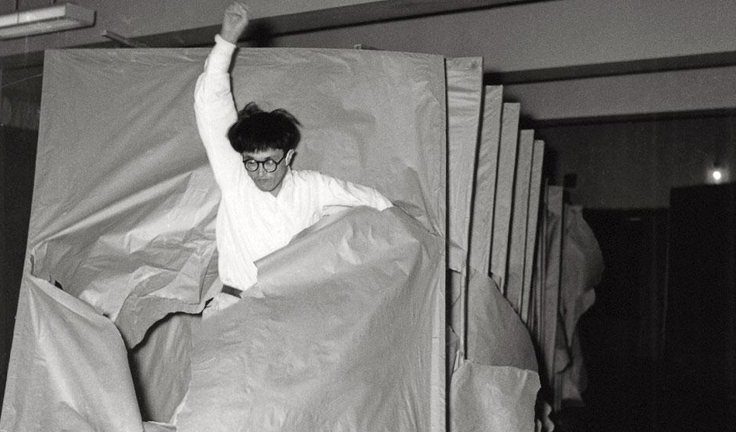
Theater is an appropriate metaphor for much of Gutai art, which often involved performance and audience participation. In many cases the action was as important as the product, which is one reason why artists like Merce Cunningham, Robert Rauschenberg, Ray Johnson and Allan Kaprow, father of the Happening, were Gutai fans. It’s fascinating to see examples, some of them re-created for this show, that prefigure process art, conceptual art, installations and New Realism in the US and Europe. Gutai artists painted with their feet, used a motorized toy car to draw, hurled jars of paint at canvas and exploded it from a cannon, and made sculptures of plastic sheeting filled with colored water, among other antics. Occasionally their work was downright dangerous, like Atsuko Tanaka’s so-called “electric dress,” a wearable sculpture made of light bulbs, and Saburo Murakami’s performance piece at the first Gutai exhibition in Tokyo, where he crashed through a series of paper screens and landed with a concussion.
Murakami’s literal breakthrough symbolizes the essence of their philosophy. As Yoshihara summarized it, “Gutai places an utmost premium on daring advance into the unknown world.” It’s clear why, in the aftermath of Japan’s defeat in World War II, such a challenge would appeal to creative thinkers. The old orthodoxies were crumbling as the whole society underwent radical transformation. In that atmosphere, vanguard artists had to look beyond their own culture for direction. Well aware of their Dada and Surrealist predecessors, as well as Abstract Expressionism’s postwar innovations, they reached out through their publication, Gutai, which they sent to interested parties abroad, including Pollock. The Pollock-Krasner House still has the copies he received in 1956, shortly before his death; one of them is in the Guggenheim show.
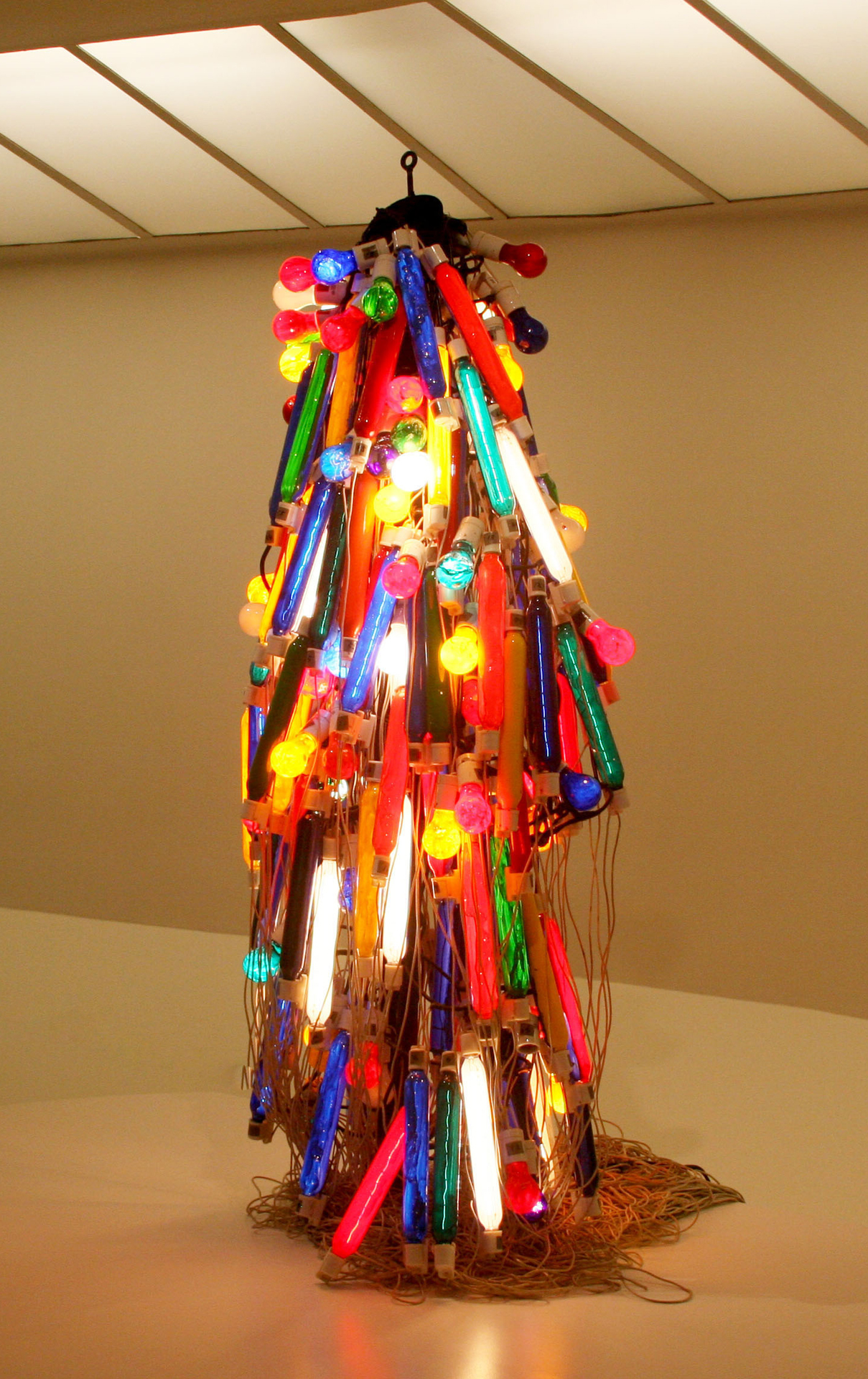
Gutai not only broke with conventional Japanese art, it also renounced the gravity of that heritage and opted for novelty and creative play. Judging by the evidence at the Guggenheim they had plenty of fun, but it was serious fun, not just amusement for its own sake. Gutai’s playfulness was an effort to engage people by intriguing them, drawing them in, getting them to let down their guard. It didn’t really work very well, at least not on a popular level. Much of the public remained skeptical, if not confused and even alienated by Gutai antics—all the more reason to cultivate an overseas audience that might be more familiar with, and receptive to, such methods. But Western critics didn’t get the joke, or appreciate the important cultural impetus behind it. Unable to see beyond its superficial resemblance to Dada, they largely dismissed Gutai art as derivative. Thanks to the Guggenheim’s long-overdue reappraisal, we can now appreciate the error of that judgment, as well as the full range of Gutai’s contribution to international modernism.
An Armory Show Homage to Duchamp
3-7-2013

A hundred years ago today, New Yorkers were flocking to the 69th Regiment Armory on Lexington Avenue to gawk, giggle and gasp at the International Exhibition of Modern Art. Of the roughly 1300 works by more than 300 European and American artists, one painting seemed to epitomize all that was aberrant in modernism: Marcel Duchamp’s Nu descendant un escalier No. 2. Ridiculed by the press as “The Rude Descending a Staircase (Rush Hour at the Subway)” and “Explosion in a Shingle Factory,” Duchamp’s 1912 canvas quickly became the symbol of how the European “fakers” and “madmen” were trying to corrupt sane and sensible America. But the harder the critics knocked it the more the public clamored to see it, with as many as 12,000 piling in on March 15, the show’s closing day.
Today another Armory Show opens in New York, and although this international art fair did occupy the actual armory for two years, it’s now housed in piers on the Hudson. Unlike its predecessor, this update is a showcase for commercial dealers, one of whom, Francis M. Naumann, has mounted a tribute to Duchamp’s masterpiece. Naumann, a respected scholar and author of books on Duchamp and Dada, assembled a selection of responses, several of them created especially for the occasion. They range from direct quotes, including a couple by Duchamp himself, to flights of fancy (pun intended). “Nude Descending a Staircase: An Homage,” opened at Naumann’s 57th Street gallery on February 15. It will be on view at Pier 94 through Sunday, after which it will move back to the gallery through the end of the month.
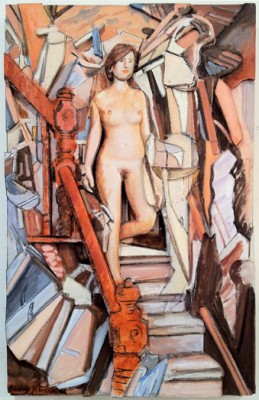
Two multiple-exposure motion studies by Muybridge—although not his 1887 woman walking down stairs, which you can see animated on YouTube—introduce the concept of capturing movement in a static medium. The photographer Gjon Mili made a time-lapse version in 1942, and Duchamp was similarly photographed, albeit fully clothed, by Eliot Elisofon for a 1952 Life magazine article. A 21st century variant by D. James Dee uses a spiral staircase and a corpulent model who is billed as naked instead of nude, shifting the focus from the world of art to the real world. Similarly, Mel Ramos’ 1987 canvas is literally a painting of a naked young woman coming downstairs, looking directly and somewhat seductively at the viewer as if to say I’m here, I’m real, and I’m yours. In 75 Years Later Revisited, his reprise of a theme he first explored in 1988, Larry Rivers set his real-life lover, Daria Deshuk, in a cubistically fragmented space, making her the calm center of a gyrating environment.
The staircase rather than the nude gets top billing in Thomas Shannon’s Slinky Descendant un Escalier, where, as the title suggests, the toy substitutes for the figure, and Tetsuya Yamada’s Endless Staircase (Double Helix version), which channels both Duchamp and Brancusi. In Sophie Matisse’s canvas, the staircase seems to climb down itself, and Wim Delvoye re-imagines it as a cross between a twisted dump truck and a spiral of Gothic architecture.
Among the direct quotes, Mike Bidlo and Sherrie Levine bring their appropriationist sensibilities to bear on Duchamp’s icon. Bidlo’s handmade versions are meant to simulate studies by the master, while Levine’s 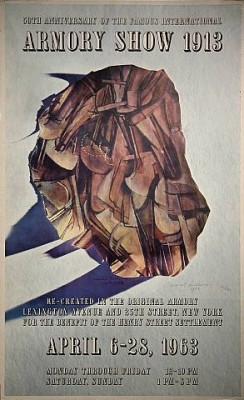 group of identical postcards of the painting illustrates how a unique work of art becomes a “readymade” through mechanical reproduction. Examples of Duchamp’s own manipulated reproductions, in the form of pochoir multiples, indicate that he was equally capable of capitalizing on the painting’s fame.
group of identical postcards of the painting illustrates how a unique work of art becomes a “readymade” through mechanical reproduction. Examples of Duchamp’s own manipulated reproductions, in the form of pochoir multiples, indicate that he was equally capable of capitalizing on the painting’s fame.
Indeed, on the Armory Show’s 50th anniversary in 1963, Duchamp collaborated with the graphic designer Herbert Matter on a poster [left] for a reincarnation of the exhibition, which was held at the original venue. An example, signed by the artist, is included in the current show. At the time Duchamp was criticized for hogging the limelight, but the painting had by then become such a talisman of the Armory Show phenomenon that it’s hardly surprising the organizers chose to use it as the literal poster child. As a college art major I visited the anniversary exhibition a few times—I still have the 1913 button replicas they gave away—and could have bought one of those posters for $25. I almost did, but in those days that was a lot of money for a student to shell out, so I passed it up. A copy in good condition now sells for as much as $7,500.
Redefining Abstraction at MoMA
2-7-2013
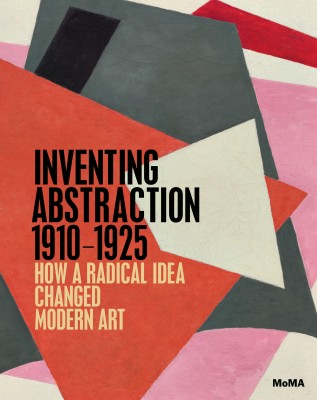
Painterly Architectonic, 1917. Oil on canvas, 31 1/2 x 38 5/8″ Museum of Modern Art, New York
The premise of “Inventing Abstraction,” the current blockbuster survey at the Museum of Modern Art through April 15, is that “traditional art was wholly reinvented” in the early twentieth century. While I question the logic of that argument, since the Western art tradition was basically thrown under the bus, the exhibition itself is amazing, if inaccurately titled. (More on that later.) It not only musters a formidable array of paintings and sculptures from the breakthrough years 1910-1925, drawn from MoMA’s own stellar collection and many other sources, but it ranges across the arts to include innovations in music, poetry, dance, photography and cinema in Europe and the United States. Art luminaries share billing with lesser known, even obscure, colleagues, and while some critics have quibbled about individual exclusions the territory is thoroughly mapped—literally so in the show’s lobby, where a huge wall chart traces the multiple connections among the key players.
In this cavalcade of isms, starting with Cubism and proliferating into Futurism, Synchromism, Orphism, Rayonism, Dadaism, Constructivism, Suprematism, Neo-Plasticism, Vorticism, etc., etc., the show presents convincing evidence that modern artists were responding to radical advances in philosophy, science and technology, as well as shifting social and political conditions. To call the era revolutionary is an understatement, with World War I epitomizing the upheaval that led to the rejection of traditional values, not only in the arts.
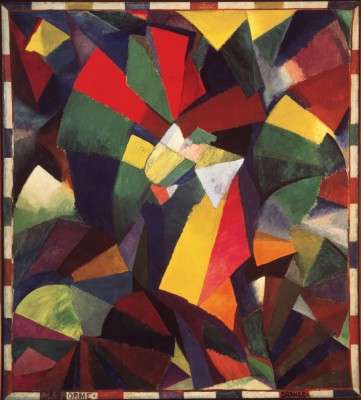
The modernists’ manifestos proclaimed iconoclastic attitudes that were promoted in their publications and performances. Exhibitions like the Salon de la Section d’Or in Paris, Futurist shows in Rome and London,“0.10” in Petrograd, Salon 2 in Odessa and the Armory Show in New York, Boston and Chicago (celebrating its centenary this year) foisted their aberrations on a puzzled public, whose ears and sensibilities were assaulted by concerts of dissonant music and grotesque dances. Those were the days when such high jinx really could shock, and MoMA’s curators have assembled the proof of just how rapidly and widely the shock waves spread, with Paris as the seismic epicenter.
Notwithstanding the exhibition’s wealth of first-rate examples from this singular era, as well as its admirable inclusiveness, its title is hopelessly misleading. These artists did not invent abstraction, and some of them weren’t even abstractionists.
All cultures practice abstraction in one form or another, and have done so for millennia. Alphabets, numbers, musical notation, money—all are abstractions that have no inherent meaning outside their cultural context. They represent the essentials of communication, just as abstract art communicates essential qualities of aesthetic experience. Picasso’s contention that “you always have to begin with something” is often cited as proof that his art was never completely abstract, but in fact that’s exactly what abstraction is: it starts with something as a point of reference or inspiration and refines it to its essence.
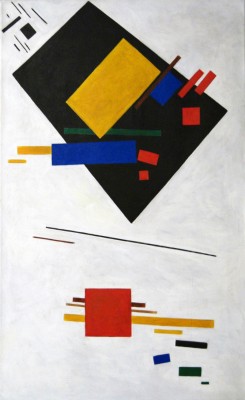
As the European and American modernists were well aware, abstract art had been around for a long time before they got wise to it. The so-called primitive cultures proved to be gold mines of significant abstract forms that inspired Cubists and Surrealists alike. Folk art and tribal art were especially fruitful. These precedents may be acknowledged in the exhibition catalogue, which I haven’t read, but they are completely ignored in the copious gallery labels, which reinforce the wrongheaded notion that abstract art is a twentieth-century Eurocentric phenomenon.
The show also errs in applying the abstract label to work that clearly derives from a different impulse—not to essentialize, but to conceptualize. Pure chromatic and formal compositions and constructions are properly classed as non-objective art because they contain no tangible outside references, however minimal or disguised. To the non-objectivists, abstract art was the bastard offspring of representation. This pure-versus-impure debate has been going on for decades and deserves a fair hearing in an exhibition that aims to analyze “the language of the modern” in all its variety and complexity.
Artists in Love
1-10-2013
According to the Symbolist poet Remy de Gourmont, “art is the accomplice of love.” In his essay, “Decadence,” he wrote: “Take love away and there is no longer art.” If only that were true! For proof that it isn’t, leaf through Veronica Kavass’ gorgeous new coffee-table book, Artists in Love, where you’ll find scant evidence of the creative flame dying when passion cools or the loved one departs. Among the 29 couples she profiles, in only one case does it appear that the loss of love triggered artistic stasis, and then only temporarily. After Sophie Taeuber-Arp’s accidental death, her grief-stricken husband paused then resumed a career that lasted another twenty years.
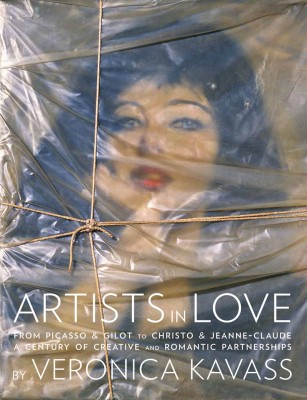
The book ranges widely through the twentieth century and into the twenty-first, starting with Wassily Kandinsky and Gabriele Münter, who went their separate ways after a tumultuous affair, and ending with Ilya and Emilia Kabakov, a married couple who collaborate on installations. It includes a few with local associations—like the Kabakovs, who live on the North Fork, and Susan Rothenberg, who had a house in Sag Harbor before moving to New Mexico when she married Bruce Nauman, as well as Willem and Elaine de Kooning, Saul Steinberg and Hedda Sterne, and of course Jackson Pollock and Lee Krasner, whose photograph came from the Pollock-Krasner House collection. When Kavass contacted me to ask for it I was glad to comply, since I could hardly imagine a book on the subject that didn’t include them.
In addition to the other obvious candidates, like Stieglitz and O’Keeffe, Rivera and Kahlo, Picasso and Gilot, etc., there are some less famous but no less deserving inclusions: Jacob Lawrence and Gwendolyn Knight (the only artists of color), Leon Golub and Nancy Spero, Barbara Hepworth and Ben Nicholson, for example. Naturally there are omissions. In her introduction, Kavass explains that she was forced to leave out Carl Andre and Ana Mendieta when permission to reproduce their work was refused—not surprising, given the still-controversial nature of Mendieta’s death. (Andre was tried and acquitted of her murder.) Edward and Nancy Reddin Kienholz are also absent, as are the Starn Twins (brotherly love), and Newton and Helen (not this one) Harrison. The most unfortunate exclusion is Gilbert and George, the British duo who have created art jointly for more than 40 years. To her credit, Kavass does include two other gay couples, but if ever there were an argument for art, love and life merging, that pair makes it. Their work is unthinkable without their relationship.
Like Gilbert and George, some of the featured couples are known for collaborative ventures, notably Bernd and Hilla Becher, McDermott & McGough, Christo and Jeanne-Claude, and Claes Oldenburg and Coosje van Brugen. In the latter two instances, Kavass points out that the female member of the team is (or was, as Jeanne-Claude died in 2009) more of a facilitator than an artist in her own right, and she’s positively catty in describing the Oldenburg-van Bruggen pairing: “Artist falls head over heels and wants to charm curator. He recreates his sculptures to her liking, under the same title, adding her name to it. Curator falls for him, marries artist, and takes over his career. What did he lose in this equation? Perhaps some pride. But otherwise, he had a ball.”
Kavass’ breezy text is peppered with occasional brickbats like that one. Her informal tone sometimes veers into snark, as when she dismisses the wealthy Surrealist painter Kay Sage as a “sugar mama” who was “completely gooey-eyed” over her husband Yves Tanguy, and describes Krasner as “Pollock’s ball-and-chain, someone [Peggy Guggenheim] had to talk through to get to Pollock.” Yes, these couples had troubled relationships, but they were also mutually supportive, often through tough times—Sage literally rescued Tanguy from the Nazis. But Kavass also comes up with some telling observations, as when Dorothea Tanning’s autobiography prompts her to imagine the artist as “a woman wrapped in velvet, resting supine on the grass, taking drags from a long ivory cigarette holder, letting the smoke shape the words.”
Interestingly, although not surprisingly, in only two cases is the female partner better known than the male, although you could argue that Kahlo has now pulled ahead of Rivera, at least in terms of critical opinion. The two in question are Eva Hesse, whose short, stormy marriage to sculptor Tom Doyle propelled her from painting to sculpture, and Marina Abramovic, the performance artist who credited her partnership with the mononymic Ulay for saving her from self-destruction. But even when the partnership was creative as well as romantic, the man is almost always the dominant figure. People who admire the designs of Charles and Ray Eames often assume that both were men, possibly brothers, rather than husband and wife.
In Artists in Love, however, the work of both sexes gets equally beautiful reproductions, many of them full page and in color, and expansively captioned. Each essay begins with a photograph of the couple, ranging from the stiff formality of the Kandinsky-Münter portrait, taken years after their affair ended, to Josef and Anni Albers’ affectionate embrace and Rothenberg and Nauman’s sweet smooching. Where they are concerned, you might agree with Gourmont that love and art are accomplices.